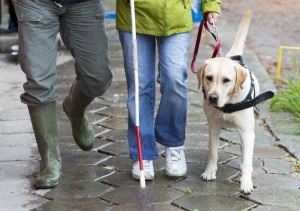College Accessibility for Visually Impaired Students
In 2009, approximately 3% of higher education students reported having some kind of visual impairment, and 90% of four-year, public colleges had resources to help students with disabilities obtain academic success. As of the 2011-12 academic year, 11% of all undergraduates nationwide had some type of disability.

Living with a visual impairment does not mean you have to put your life on hold. If you have dreams of earning a college degree, that opportunity is available to you. Through mobile phone applications, computer software and student services and groups, individuals with a visual impairment can make the transition to college life as smoothly as other students.
Below, we have compiled a collection of resources designed to help visually impaired students transition into higher education and achieve success in the college classroom once enrolled. Along with a look at who to talk to on campus and what services and tools students can access, we provide a list of scholarships specifically for students with visual impairments.
What Are Visual Impairments?
A visual impairment is a functional limitation in the eyes. For a variety of reasons, the eyes do not always work as they should. While certain impairments are treatable, the following conditions cannot be fixed with corrective lenses.
- Blindness is classified as total blindness if the student demonstrates a visual acuity of 20/400 or worse, with a visual field of less than 10 degrees. A student may be classified as legally blind if they cannot read any of the letters on the 20/100 line of a clinical visual exam. In a 2002 American Council on Education survey, 1.1% of first-year college students reported being blind or partially sighted. Blind students typically depend on assistive technology to follow visual assignments and presentations in the classroom. They have also reported facing social challenges, stemming from an inability to see and read social cues.
- Common visual impairments include low vision and light sensitivity issues. A student who is visually impaired has visual acuity of 20/70 or worse, even with correction. According to the same survey mentioned above, 13.3% of students with a disability reported partial sight issues or blindness. Vision impairments may prevent students from seeing instructional materials and visual presentations in class.
- Other health conditions affecting student vision may include degenerative loss of vision or low or limited vision resulting from an accident or medical condition, such as diabetes. Additionally, computer strain syndrome is increasingly common today among students who must view screen-delivered content for extended periods of time.
Succeeding in College
While college-bound students with visual impairments face their share of challenges, modern technology has made school more accessible than ever before. Applications and computer software allow students to attend classes, but it is also important that visually impaired students create a social support system on campus.
When visiting the schools you are considering, request a meeting with a student services representative about available resources for visually impaired students. Be sure to ask about any special devices they have for students with disabilities, such as Braille readers or voice-recognition computer systems. Some schools also offer special staffing and other accommodations for students with visual disabilities, including priority seating and testing arrangements, note-taking services and recorded audio lectures.
Adjusting academically and socially can be challenging for any freshman student, and visually impaired students are no exception. While meeting with student services, ask about available transition services, such as counseling and teaching aides, to help you ease into campus life.
- Get involved in the student community: College students with visual impairments should not feel isolated from other students or excluded from school activities. Today, there are a variety of on-campus clubs, organizations, sororities and fraternities that welcome participants with visual disabilities. Visually impaired students can be advocates within the student government for others with similar conditions and can join Greek life organizations that support charities for the blind. Do not hesitate to reach out to your peers to learn about additional support opportunities.
- Take full advantage of the resources available to you: Use resources that may help you supplement effective learning practices in the classroom. Large-print textbooks and front-row seats, for example, can help students make the most of their time in class. Be assertive about your requests for special accommodations when you need them to enhance your learning experience: only you know what learning tools are right for you.
- Know your legal rights as a student with a disability: The law protects the rights of students with visual and other disabilities. Be sure to know your rights when you get to campus.
- Section 504 provides equal benefits, opportunities and services to students with disabilities on college campuses and other federally funded academic and corporate institutions. Known as The Rehabilitation Act of 1973, it is among the first pieces of disability rights legislation in the U.S. and is overseen by the Office of Civil Rights in the USDE. Every student who is a “qualified individual with a disability” according to Section 504 must be provided with appropriate accommodations, including equal access to classrooms. While schools not receiving federal funding may be exempt from upholding Section 504, they still likely adhere to an alternate form of legislation that protects disability rights.
- The Americans with Disabilities Act (ADA) protects students at both public and private academic institutions under Title II and Title III legislation; ADA is governed by the U.S. Department of Justice, as opposed to a branch of the federal education system. Students with disabilities are protected against discrimination in services, programs and activities provided by public institutions via Title II, while students at private schools are afforded the same protection through Title III provisions. Title III also requires all eligible institutions to administer education in an environment accessible for all students.
- The Assistive Technology Act protects students with disabilities. Through the Tech Act, state-run institutions may be eligible for grants to help them purchase assistive technologies and devices for students with disabilities, including wheelchairs, voice-amplifying learning systems and other software.
Keep in mind that larger schools can generally provide more resources, more courses and a larger support network for visually impaired students. However, that doesn’t make a larger campus the obvious choice; smaller schools have lower class sizes and a personalized educational experience, which is alluring as well.
Scholarships for Blind and Visually Impaired Students
The Fred Scheigert Scholarship
- Sponsor: Council of Citizens with Low Vision International
- Amount: $3,000
- Application Deadline: March 1, 2016
- Eligibility: Must have low vision of at least 20/70 in the better eye; should have low vision but are still able to effectively use low vision devices to perform daily tasks. Must be registered for at least 12 undergraduate or nine graduate units as full-time students, with a GPA of 3.2.
- Sponsor: National Federation of the Blind
- Amount: $3,000 – $12,000
- Application Deadline: March 31, 2016
- Eligibility: Must be legally blind in both eyes and registered as full-time students or part-time students while working full time.
- Sponsor: The Lighthouse Guild
- Amount: Up to $10,000
- Application Deadline: March 31, 2016
- Eligibility: Must be legally blind in both eyes and planning to enroll as a college freshman in the upcoming school year; all other qualifications are based on merit.
The Graduate School Scholarship
- Sponsor: The Lighthouse Guild
- Amount: Up to $10,000
- Application Deadline: March 31, 2016
- Eligibility: Must be legally blind in both eyes and pursuing a post-baccalaureate degree; all other qualifications are based on merit.
The Brother James Kearney Scholarship Program for the Blind
- Sponsor: The Lavelle Fund for the Blind
- Amount: Up to $15,000 per student, per academic year, for up to four years.
- Application Deadline: Ongoing; currently admitting new applicants enrolled through June 30, 2019
- Eligibility: Must be legally blind as determined by Lavelle Fund-affiliated vision specialists and demonstrate financial need. Students must be studying at one of 11 participating schools in NYC.
American Council of the Blind Scholarship Program
- Sponsor: American Council of the Blind
- Application Deadline: March 1, 2016
- Eligibility: Must be legally blind in both eyes, registered as full-time students with a GPA of 3.3, though extenuating circumstances outside of this GPA may be considered.
The Delta Gamma Foundation Florence Margaret Harvey Memorial Scholarship
- Sponsor: American Foundation for the Blind
- Amount: $1,000
- Eligibility: Must show proof of legal blindness with application; open to applicants in undergraduate or graduate study in blindness/visual impairment rehabilitation or education.
The Rudolph Dillman Memorial Scholarship
- Sponsor: American Foundation for the Blind
- Amount: $2,500
- Eligibility: Must show proof of legal blindness with application; open to applicants in full-time undergraduate or graduate study in blindness/visual impairment rehabilitation or education.
The Karen D. Carsel Memorial Scholarship
- Sponsor: American Foundation for the Blind
- Amount: $500
- Eligibility: Must show proof of legal blindness with application; open to full-time graduate students.
The Paul and Ellen Ruckes Scholarship
- Sponsor: American Foundation for the Blind
- Amount: $2,000
- Eligibility: Must show proof of legal blindness with application; open to full-time undergraduate or graduate students in engineering or physical, life or computer science.
Assistive Technologies for Visually Impaired Students
There are a number of tools available to support students with disabilities. Assistive technologies for visually impaired students are provided by colleges or through alternative means.
Accommodations provided for students by the college include access to materials and facilities during class that can augment the learning process for students with visual impairments. Examples include:
- Recorded lectures: Students may benefit from audio lectures and/or recordings made during class. Students can replay the audio as needed to review course material in their own time after class. Common recording tools include handheld digital voice recorders and digital note-taking devices. You may also use an app, such as Audionote, to create audio files of lectures during class.
- Reserved seating at front of classroom: Students with low or limited vision should make arrangements for front-of-class seating in every class. Don’t hesitate to let your instructors know of your vision impairment; they will find seating for you throughout the year. Additional arrangements can be made for visually impaired students using a guide dog or long cane.
- Braille textbooks: Your text-based learning materials may need to be delivered in an alternative format. Your instructor should make Braille textbooks and/or other written materials available to you if needed. For students with low vision or limited eyesight, minor changes to typed handouts or assignments in class, such as a larger or cleaner typeface, may increase readability.
Outside apps and software tools for the visually impaired are designed to supplement the traditional classroom learning experience. From mobile apps to software and special programs, the following represent a selection of commonly used tech tools among visually impaired students:
- Screen readers allow students to read the text on a computer screen using a voice synthesizer and Braille-based key commands. With an advanced screen reader, students can read the text on a Webpage and navigate the page, using commands such as “announce cursor position” and “refresh page.” There is a variety of screen reader software available, depending on your computer’s operating system and the features you need. NVDA, for example, is a free program for Windows that offers basic functions, including screen view through Braille display, navigation and speech synthesizer capabilities. Additionally, there are several versions of COBRA, Hal and JAWS programs, including multiple Braille key displays and enhanced voice synthesizer options, compatible with Linux, Windows and Mac systems.
- Voice-to-text word processors can be extremely helpful in translating spoken dictation into written documentation. From navigating the web to dictating an email, this technology is a well-rounded tool for the visually impaired. Voice-to-text app Dragon NaturallySpeaking for PC is designed to recognize naturally occurring patterns in your speaking voice to accurately transcribe your speech into text. For PC users, recent Windows operating systems come with an optional “dictate” feature, turning voice into text content through the computer’s built-in microphone.
- Other helpful tech resources include BrailleTouch for students looking to type faster using the Perkins Brailler key display. This iPhone app turns your touch screen into a Braille keyboard and can automatically convert the Braille type into texts, emails and social media posts. ZoomText, which is ideal for students with low or limited vision, magnifies selected text, image and video content and reads content aloud through voice amplification. SpeakIt! provides similar assistance, playing selected web content out loud to users through an extension in the Google Chrome browser.



